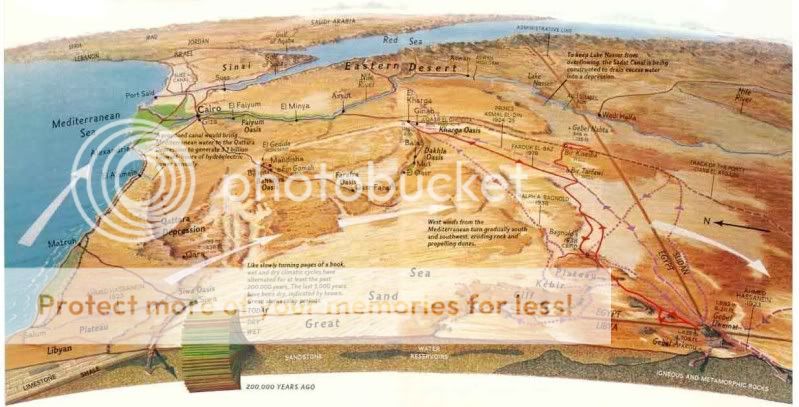Sihouette
Well-Known Member
- Joined
- Jun 16, 2008
- Messages
- 1,635
A friend of mine and I were talking just the other day about another whacky but??? idea of flooding the Sahara Desert with seawater, creating an inland sea that would change the climate of the Sahara to one of more moisture. Evaporation from that sea would undoubtedly change the weather patterns over the Sahara. One could predict an increase in rainfall in certain areas. One could plant those areas with heat/drought tolerant trees and begin to re-establish the micro-climates of those areas to even potentially sustain agriculture. Take the water from that saline inland sea and desalinate it using solar power readily availible in the region, and use it to begin irrigating these marginal areas. Energy might even be made from thermal saline ponds like the one in Israel.
Don't laugh. It could work. And it would take a tiny dent out of sea levels rising. It might even encourage a restablizing of the ice caps since the Sahara is as big as the whole of the United States and thensome as memory [and atlas] serve. As areas begin to re-green we could expand them inwards until they met. This would be a project for many decades but oh what a worthwhile one?
This idea isn't even quite as farfetched as some proposed by scientists today to affect global warming. It would be a simple affair to pump the water into the Sahara, the real challenge would be the geologists determining where the boundaries of that sea could be. It might not even have to be that big in order to affect the climate there just enough to spark the change.
In addition, a vast area reclaimed like the Sahara and re-greened would have to have a dent in the CO2 problem in the atmosphere. After all, plants drink in C02 and breathe out oxygen..
I'm thinking this climate-conditioner could buffer quite a bit of human industrialized activities. Once the region is stabilized and temperatures are tolerable, sand dunes stop drifting etc., there may even be great potential for oil exploration there, and so on. Again, this place is bigger than the continental US, just one big sandbox waiting to be converted. Right in front of our faces every time we look at a map..
Don't laugh. It could work. And it would take a tiny dent out of sea levels rising. It might even encourage a restablizing of the ice caps since the Sahara is as big as the whole of the United States and thensome as memory [and atlas] serve. As areas begin to re-green we could expand them inwards until they met. This would be a project for many decades but oh what a worthwhile one?
This idea isn't even quite as farfetched as some proposed by scientists today to affect global warming. It would be a simple affair to pump the water into the Sahara, the real challenge would be the geologists determining where the boundaries of that sea could be. It might not even have to be that big in order to affect the climate there just enough to spark the change.
In addition, a vast area reclaimed like the Sahara and re-greened would have to have a dent in the CO2 problem in the atmosphere. After all, plants drink in C02 and breathe out oxygen..
I'm thinking this climate-conditioner could buffer quite a bit of human industrialized activities. Once the region is stabilized and temperatures are tolerable, sand dunes stop drifting etc., there may even be great potential for oil exploration there, and so on. Again, this place is bigger than the continental US, just one big sandbox waiting to be converted. Right in front of our faces every time we look at a map..

